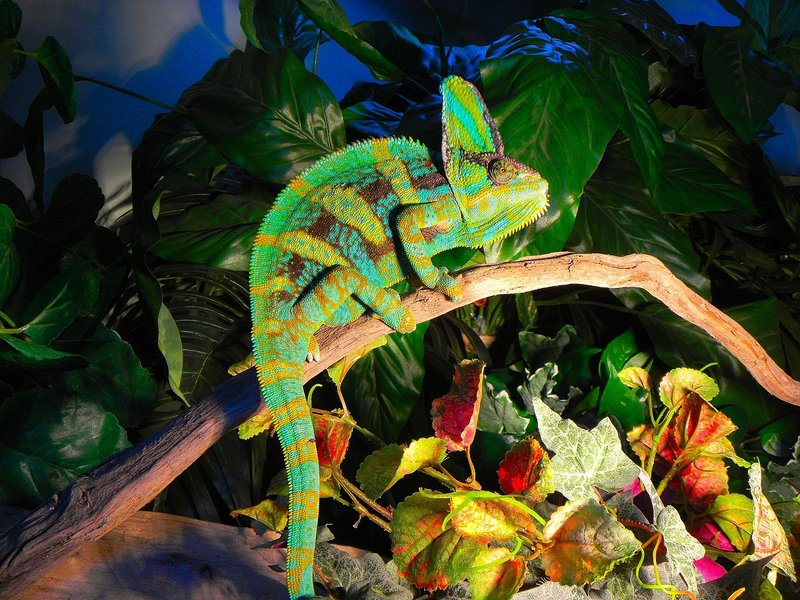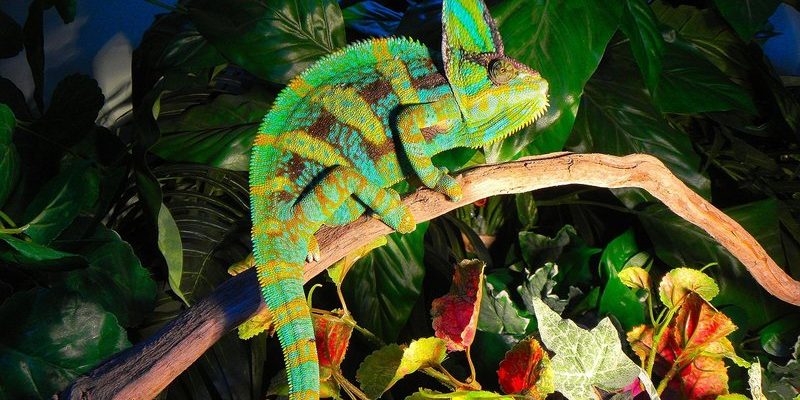
Now, you might be wondering, what makes the veiled chameleon stand out in a world filled with vibrant and exotic creatures? Well, think of it this way: just as a painter uses a palette to express emotions and ideas, the veiled chameleon uses its color-changing abilities to communicate feelings and reactions. This remarkable ability gives it a special role in cultural myths and stories, making it not just a reptile but a symbol of change and adaptability. Join me on this journey as we explore the veiled chameleon’s importance in culture and symbolism.
A Symbol of Change and Adaptability
The veiled chameleon is a prime example of how nature teaches us lessons about change. Much like how we go through different phases in our lives, this creature transforms its colors in response to its environment. When adapting to their surroundings, chameleons can switch from vibrant greens to browns, which symbolizes flexibility and adaptability.
In many cultures, this ability to change has been interpreted as a metaphor for personal growth. For instance, when someone faces challenges, like moving to a new city or starting a new job, they might feel like they need to “adapt” just like a chameleon. It’s a powerful reminder that change can lead to growth, and embracing it can help us thrive.
This connection to change also appears in various folklore and stories. In some traditions, chameleons are seen as messengers that remind us of the importance of adjusting our perspectives to see the world in different ways. Just imagine how your day could change by simply altering your viewpoint!
Veiled Chameleons in Art and Literature
Art often reflects the essence of the world around us, and the veiled chameleon has made its mark in various artistic forms. From paintings to sculptures, these creatures have inspired artists to convey themes of transformation and renewal. Their unique physicality, with bright colors and intricate patterns, makes them visually captivating subjects.
In literature, the veiled chameleon appears as a symbol of transformation and identity. Think about stories where characters evolve or discover new sides of themselves. Just like the chameleon changing its skin, these characters often mirror the ever-changing nature of humanity. For instance, in some stories, a character may face adversity but ultimately adapt and grow stronger, much like our chameleon friend.
Moreover, the veiled chameleon’s role in literature isn’t limited to just transformation. It also embodies the idea of camouflage and hidden truths, encouraging readers to look beyond the surface. So, the next time you come across a story featuring a chameleon, take a moment to appreciate the deeper meanings at play.
Cultural Significance Across Different Societies
Throughout history, the veiled chameleon has held various meanings in different cultures. In some African and Middle Eastern traditions, chameleons are viewed as symbols of wisdom and perception. Their ability to blend into their surroundings makes them a metaphor for being observant and aware of one’s environment, which is essential for survival.
In contrast, other cultures may see them as omens or symbols of change. For instance, in certain Native American beliefs, the chameleon represents balance and the importance of adapting to one’s circumstances. This cultural significance emphasizes the universal importance of change in our lives and the need to embrace it, rather than resist it.
By understanding these different interpretations, we can appreciate how the veiled chameleon serves as a bridge connecting us to humanity’s collective wisdom. It encourages us to celebrate diversity and the unique ways different cultures interpret the lessons of nature.
The Veiled Chameleon in Modern Symbolism
In contemporary times, the veiled chameleon continues to capture our imaginations and is often seen in popular culture. You might encounter it in various media, from documentaries showcasing its colorful beauty to animated films where it represents uniqueness and adaptability.
In psychology, the chameleon effect refers to the phenomenon of humans unconsciously mimicking others, much like how chameleons change colors to fit in. This concept highlights our innate desire to connect and adapt to those around us. The veiled chameleon, therefore, not only serves as a symbol of change but also reminds us of our social nature.
Additionally, many people embrace the chameleon as a tattoo symbol, representing personal growth, transformation, or the ability to adapt to life’s challenges. When someone chooses a veiled chameleon as a tattoo, they often carry a message about their journey of change and resilience.
The Veiled Chameleon in Conservation Culture
As we delve deeper into the significance of the veiled chameleon, it’s important to address its role in conservation efforts. As a species, chameleons face various environmental threats, including habitat loss and climate change. Their unique nature makes them a focal point for conservation messages, emphasizing the need to protect our planet’s biodiversity.
Groups focused on wildlife conservation often use the veiled chameleon to illustrate the broader impact of climate change and the importance of preserving habitats. By raising awareness about the significance of these creatures, we are reminded that taking action for the environment is crucial for maintaining balance in nature.
Awareness campaigns often leverage the chameleon’s symbolism of adaptability to encourage people to adjust their lifestyles for a sustainable future. In this way, the veiled chameleon not only serves as an important cultural symbol but also as a call to action for environmental stewardship.
The veiled chameleon is so much more than just a colorful lizard; it’s a powerful symbol of change, adaptability, and growth. Across cultures and throughout history, this magnificent creature has taught us valuable lessons about navigating life’s challenges and embracing our evolution.
From its artistic representations to its vital role in conservation, the veiled chameleon continues to inspire and connect us. As we reflect on its significance, let’s remember the importance of being adaptable in our own lives and recognizing the beauty of change. Embracing the lessons of the veiled chameleon can lead us to a more fulfilling life—one that’s rich with growth, understanding, and connection to the world around us. So, the next time you encounter a veiled chameleon, take a moment to appreciate its unique contribution to our cultural landscape.

